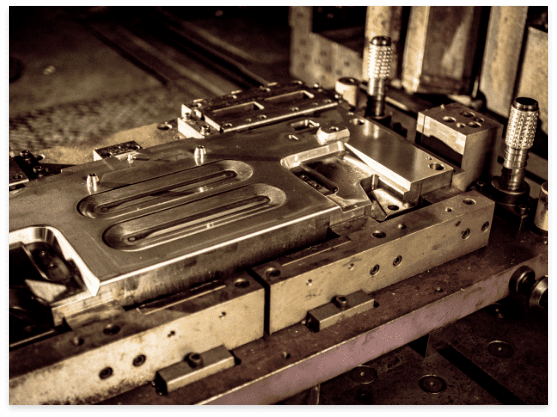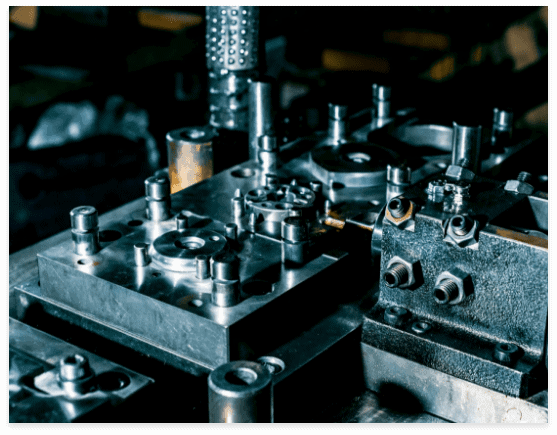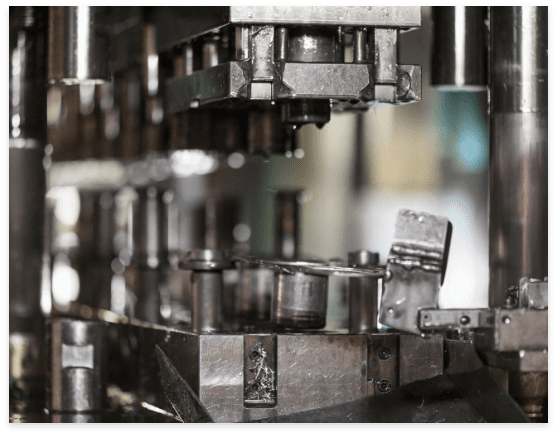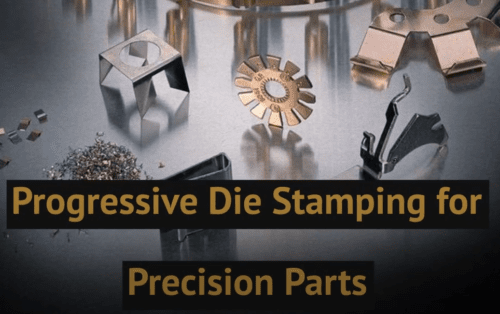Progressive Die Stamping for Precision Parts
What is Progressive Die Stamping?
PROGRESSIVE STAMPING IS DISTINCT FROM OTHER TYPES OF STAMPING, SUCH AS:
- Transfer Stamping
Transfer Stamping
Parts are separated from the strip early in manufacturing and are transferred to different stamping machines, whereas progressive stays connected to the strip until the end of the process. - Fine Blanking
Fine Blanking
A high pressure operation in which a single workpiece is clamped into position for blanking and is then ejected. - Four Slide Stamping
Four Slide Stamping
Unlike progressive stamping, this method uses no dies, and instead uses sliding tools (often but not always four of them) that strike the workpiece from different directions to shape it.
The Role of Tooling and Dies
Tooling is a broad term for the mechanical components within a press that hold dies and help direct metal strips through the press. Plates, jigs, fixtures, and the actual dies are examples of tooling.
Dies are a specific type of tooling that cut, shape, or remove portions of the material to create the actual parts. In precision stamping dies must be manufactured with great care to make precise changes to the metal. They must also be durable enough to withstand thousands of strikes without excessive wear. This can lead to out of tolerance parts and high amounts of scrap, which waste time and money.
Material selection for tool building is almost as important as for the stamped parts themselves. Common materials include ferrous alloys including tool steel and carbide. Depending on anticipated production volume, the material being stamped, and the purpose of the tool (i.e., short-run prototyping), different materials may be more or less appropriate.
When selecting a stamper for custom precision parts, you’ll need to determine if you will transfer your existing tooling (if available) or have your stamper make new ones. While it may seem like an easy decision to use what you already have, an experienced stamper may be able to maximize efficiency and lower scrap rate when building a new tool. Another reason to consider having new tooling made is if your stamper provides lifetime maintenance for the tooling – it’s a service that’s worth seeking out for a long term investment. Read more about the decision to transfer tooling or have a new set made here.
Common Materials for Precision Stamping

A VARIETY OF METALS ARE USED IN PRECISION DIE STAMPING INCLUDING, BUT NOT LIMITED TO:
- Stainless steel
- Aluminum
- High- and low-carbon cold rolled steel
- Pre-galvanized steel
- Nickel-plated steel
- Brass
- Copper and copper alloys
When selecting material for a project, it’s important to consider mechanical and physical properties of the metals. These include, but are not limited to, bendability, conductivity, hardness, corrosion resistance, and other properties.
The final use of a part also determines which properties are most important. For example an EMI shield needs to be strong but also solderable in order to attach to a PCB. Therefore, one characteristic of the chosen metal may outweigh the other. Material selection for custom applications is generally done on a case by case basis. Read more about material considerations here.
Be aware that a precision die stamper will often specialize in materials of certain sizes and thicknesses and specify a maximum press tonnage. CEP Technologies, for example, works with blanks up to 6” x 6”, and thicknesses less than 0.080,” as well as a maximum of 60 tons per press. A specialist stamper like this will be highly familiar with the materials and processes used for miniature to small stampings.
Why Choose Progressive Die Stamping?
Progressive die stamping is a fast, economical way to manufacture a large volume of custom parts. The process is highly repeatable, which means more in-tolerance parts and less scrap and rework.
Look for a stamper who provides project lifetime tool maintenance, like CEP Technologies. The ability to repair, sharpen, and maintain tooling and dies saves you time and money in the long run instead of having to manufacture new tooling at future points in production.
Progressive stamping methods are used in many industries including medical, automotive, EMI/RFI shielding, communications, aerospace, military applications, and electronics. Some examples of specific applications include, but are not limited to:
- Engine, transmission, and advanced driver assistance systems (ADAS) sensors
- Vehicle communication systems
- EMI/RFI shields for vehicles and consumer electronics
- Custom battery contacts
- Key fobs and door lock components
- Ignition and fuel pump components
- Vehicle Infotainment systems
- Clips, pins, and brackets
- Medical devices
CEP Technologies’ Progressive Die Stamping Process
Progressive die stamping projects begin with designing the die and is followed by a tool build. Our expert team can design and build progressive dies to accommodate nearly any part or production need. Once the tools are ready, we can start the actual stamping process.
The first step of the progressive die stamping process is setting the tool into our power press and adjusting the feed settings. Next, the machine operator carefully passes the coil strip material through the tool in sequence. This is especially important as there are multiple stamping stations present in the setup.
CEP Technologies’ tooling is built for high volume production. All of our tooling is built to last so that we can guarantee it for the life of our customers’ projects. However, it is essential to use the proper progression and pitch distance to ensure production parts are produced accurately and efficiently. The final step of the process is running the machine; depending on size and geometry of the part each stroke of the press can produce a single or multiple parts.
Finding the Right Stamping Partner for Your Needs

While the actual precision stamping is important, there are more things to consider when choosing a stamping partner. After all, the success of your stamping project directly impacts the success of your final product and your bottom line.
Be strategic when choosing a stamper. It’s worth the time to discuss things like total cost of ownership of tool and die manufacturing and maintenance, their design expertise and ability to suggest design modifications to improve manufacturability, value added services offered like cleaning and packaging, and vendor managed inventory (VMI) and purchasing agreements for raw materials. Take a deep dive on these and other ways to assess a stamping vendor here.

What’s more, a stamper who offers prototyping services can help you find the most efficient, manufacturable design that meets requirements. These services can include, plating, laser cutting, photo-chemical etching, and more. Here is an example of just how effective prototyping can be.
When you work with CEP Technologies, you get more than just a precision die stamping vendor, you get an experienced partner. We can review your design, discuss options for materials, and keep your project moving. Please contact us for a free quote on your custom miniature to small stamping or prototyping project, or read more about us!

